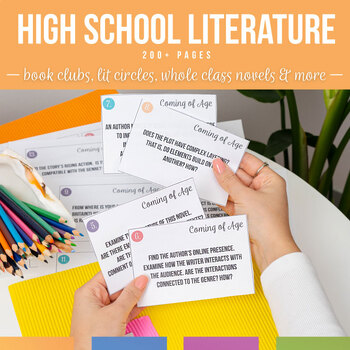High School Literature Activities Bundle | Literature Circles Teacher Resources
- Zip

What educators are saying
Products in this Bundle (10)
showing 1-5 of 10 products
Bonus
Description
Teaching high school literature and meeting high school literature standards requires a diverse set of tools. Included in this literature bundle are activities specifically geared toward older students.
In this literature bundle, you'll find activities that will work year after year and with a variety of students for literature circles, independent reading, whole class novels, and more. TEN different literature activities for high school are included.
Specifically included in this high school literature bundle:
Text Analysis Graphic Organizers: Character Analysis and Inferences
Focus on character and theme analysis and their complexity by honing on specific
parts (like motivation) with these graphic organizers.
Literary Analysis Prompts: Digital & Print Literature Writing Prompts
Choose from 25 writing prompts that will work with any piece of literature. These questions specifically move students toward literary analysis. Assign certain questions or allow students to choose their questions.
Digital Literary Analysis Activity: Scaffolded Literary Analysis Activity
Build analysis with digital building blocks. As students begin to "build" their analysis, add more pieces to show connections between literary pieces of any story. This scaffolded literary analysis activity is the perfect starting point for a literary analysis essay or alternative to the literary analysis essay.
Literature Cards Lit Circle - Book Club - Independent Reading Questions
Use these forty cards with any piece of literature! An editable teacher's guide is included. You can use these questions for literature for exit tickets, small group writing, literary analysis essays, or conversation starters.
Language in Literature - Lit Circles, Book Clubs, & Independent Reading
When I needed to meet language standards with older students, I turned to the literature they were reading. These activities will help you meet high school language standards by analyzing literature.
Dystopian Literary Analysis Dystopia Lit Circle, Book Study Activity
Teaching a dystopian text or dystopian literature circles? Add these diverse tools to any piece of dystopia.
Memoir Questions Lit Circle - Book Club - Independent Reading Questions
Whatever memoir you and your students read, you can add these questions to your study. Since the questions are completely editable, you can add them wherever and whenever you need them.
Postmodern Questions Lit Circle - Book Club - Independent Reading Questions
Add these forty questions (in card form and an editable version) to any postmodern literature lesson.
Coming of Age Questions Lit Circle - Book Club - Independent Reading Questions
Add this presentation, quiz, and twenty questions to any coming of age unit.
Literature Pretest | High School Literary Terms, Genres, and Poetic Devices
Use this editable and self-grading quiz over common literary terms and domain-specific terms to gauge where your students are in their understanding of foundational ideas for literature.
These literature activities will work all year with a variety of activities:
√ Book clubs
√ Literature circles
√ Independent reading
√ Whole-class novels
√ Short stories or excerpts
As a bonus, I have included ideas for running literature circles with high school students.
Other literature activities for older students:
→ Literary Devices Coloring Sheets & Bookmarks TWENTY Literature Coloring Sheets
→ Literary Devices Graphic Organizers
→ Eighth Grade Review Grammar, Reading, Writing, Listening EDITABLE
~~~~~~~~~~~~~~~~~~~~~~~~~~~~~~~~~~~~~~~~~~~~~~~~~~~~~~~~~~
A Couple Tips:
* Be sure to click the "follow" button that is located next to my picture so that you can hear about sales, updated products, and new activities.
* By providing feedback on your purchased products, you can earn points, which ultimately translate into cash toward future purchases.





